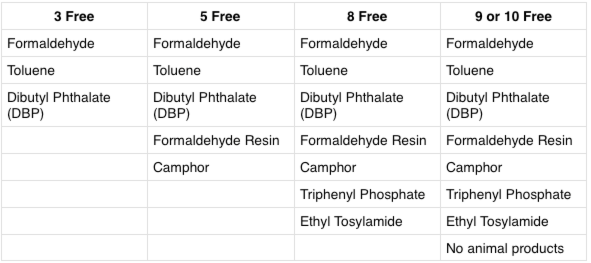Nail Polish
3-free, 5-free, 8-freeNail polish has made significant strides in eliminating harmful ingredients but most (even 8-free) still contain an endocrine-disrupting ingredient, benzophenone-1.
While no nail polish is completely non-toxic since it is essentially paint, there are much better options available now.
What Makes Nail Polish Toxic
You might wonder how harmful chemicals in nail polish effect the body.
Studies have shown that harmful ingredients such as triphenyl phosphate (TPHP) enter the body by dermal absorption from the nail polish application. Urinary concentrations of TPHP metabolites were significantly less when painted on a synthetic nail on a gloved hand versus directly onto a natural nail. TPHP is associated with endocrine disruption.[1][2][3]
The second and more obvious route is inhalation, which effects the user and those around them (especially nail salon workers.) One study used organic vapor monitors to measure personal exposure to three types of VOCs found in nail polish products: toluene, acetone, and methyl methacrylate (MMA) which is found in bonding of artificial nails. Exposure to these VOCs was associated with headaches, lightheadedness, and irritation to the nose, eyes, throat, and skin, which is in line with self-reported health effects from salon workers.[4]
Safer options have entered the market over the years which avoid a certain number of ingredients in the formula. The following table indicates which ingredients are excluded from polishes with the following labels.
Ingredients Excluded In Nail Polish
The first group of safer nail polish started with “3-free” polishes, which refer to three widely known toxic chemicals. The most restrictive to date are “8-free” which exclude TPHP, ethyl tosylamide, and xylene. Brands that indicate “9-free” or “10-free” are typically the same as “8-free” but promise a vegan formula and/or exclusion of animal ingredients.
Here are descriptions of each of these ingredients and associated health concerns:
Formaldehyde- carcinogen and immune/respiratory/skin toxicant that is restricted in cosmetics in Canada but not the U.S.[7]
Toluene – Aromatic hydrocarbon for which exposure can cause toxicity throughout the body affecting the pulmonary system, central and peripheral nervous system, gastrointestinal, cardiovascular, renal, hepatic, dermal, and hematological systems. Toluene is included in the California Proposition 65 list for reproductive and developmental toxicity. Found unsafe for use in cosmetics by the International Fragrance Association Codes and Standards and CosIng (European Commission database for information on cosmetic substances).[6]
Dibutyl Phthalate (dbp) – respiratory toxicant that is banned by the European Union in cosmetics and personal care products. California Proposition 65 classifies DBP as a developmental and reproductive toxicant. Evidence of endocrine disruption and immune system toxicity as well as being a represent.[5]
Formaldehyde Resin- Main allergen responsible for contact dermatitis to nail polish.[8]
Camphor- While used is various topical treatments, camphor can be harmful if applied to broken skin or used in high doses. Camphor should be avoided if one is pregnant or breastfeeding.[9]
Triphenyl Phosphate (TPHP) – Used as a flame retardant and plasticizer, TPHP is an endocrine disruptor with obesogenic effects. Studies indicate reproductive and developmental toxicity, and genotoxicity associated with TPHP. Human studies suggest that TPHP exposure alters endocrine function and impacts reproduction, alters thyroid hormone levels, and decreases semen quality.[12]
Ethyl Tosylamide –been banned from personal care products in Europe due to concern over antibiotic resistance.
Xylene- Volatile organic compound that can irritating to the skin, eyes, and respiratory tract and toxic to the central nervous system.[10][11]
Benzephenone-1 is associated with endocrine disruption and skin toxicity, and may accelerate growth of breast cancer cells and promote cancer metastasis. [13][14][15]
Safer Nail Polish Options
Beginning with a non-toxic base coat reduces exposure to potentially harmful ingredients (regardless of the color polish you choose).
The beautiful Cote Nail polishes sold at Paris Laundry perform just like your favorite traditional polish but with the safest possible ingredients. It is important to note that while Cote is phasing out benzophenone-1, some still contain it. All of the Cote polishes sold at Paris Laundry are free of benzophenone-1.
Sienna Byron Bay has a large selection of beautiful shades, also with the safest ingredients. Sienna’s base coat and top coat, called The Foundation and The Shield, make a great combo for a shiny, lasting, and safer mani/pedi. Sienna’s Base Coat doubles as a nail hardener to help keep nails strong.
Switch
Opi contains formaldehyde resin, triphenyl phosphate, ethyl tosylamide, and camphor.
How to Buy
Save 15% on Cote polishes at Paris Laundry with code SWITCHNATURAL15. Purchase direct from Sienna Byron Bay with free shipping over $50.
Tips For Healthy Nails
In addition to using safer polish, here are some tips to reduce exposure to toxins in your nail care routine.
Reduce toenail polish application to summer and spring months, giving toenails a break in the fall and winter.
Skip acrylics, gel, and shellac and opt for a less toxic polish option like Cote or Sienna Byron Bay.
When you remove nail polish, take a week or longer break before re-applying nail polish.
File, buff, and apply cuticle oil when not using nail polish. The Bare Hands kit is perfect to maintain shiny, healthy nails without polish.
Switch out acetone and traditional nail polish removers for a soy-based one like Priti NYC Unscented Nail Polish Remover.
References & Resources
[1] https://www.ewg.org/release/duke-ewg-study-finds-toxic-nail-polish-chemical-women-s-bodies
[2] https://www.ewg.org/research/nailed
[3] Nail polish as a source of exposure to triphenyl phosphate - ScienceDirect
[4] https://www.ncbi.nlm.nih.gov/pmc/articles/PMC6913878/
[5] https://www.p65warnings.ca.gov/fact-sheets/di-n-butyl-phthalate-dbp
[6] https://www.ncbi.nlm.nih.gov/books/NBK532257/
[7] https://www.cancer.org/cancer/cancer-causes/formaldehyde.html
[8] https://www.ncbi.nlm.nih.gov/pmc/articles/PMC5514594/
[9] https://pubchem.ncbi.nlm.nih.gov/compound/camphor#section=Exposure-Routes
[10] https://www.ncbi.nlm.nih.gov/pmc/articles/PMC6161385/
[11] ATSDR - Medical Management Guidelines (MMGs): Xylenes (cdc.gov)
[12] https://www.ncbi.nlm.nih.gov/pmc/articles/PMC4662901/
[13] https://pubmed.ncbi.nlm.nih.gov/23328252/
[14] https://pubmed.ncbi.nlm.nih.gov/25849766/
[15] https://www.ncbi.nlm.nih.gov/pmc/articles/PMC4997468/
[16] https://www.ncbi.nlm.nih.gov/pmc/articles/PMC6377152/









